
BMW R27
Encyclopedia
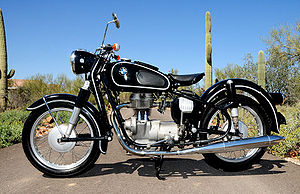
Motorcycle
A motorcycle is a single-track, two-wheeled motor vehicle. Motorcycles vary considerably depending on the task for which they are designed, such as long distance travel, navigating congested urban traffic, cruising, sport and racing, or off-road conditions.Motorcycles are one of the most...
manufactured by BMW
BMW Motorrad
BMW Motorrad is the motorcycle brand of the German company BMW, part of its Corporate and Brand Development division. The current General Director of the unit is Hendrik von Kuenheim....
.
History
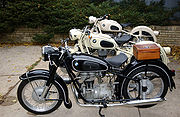
World War II
World War II, or the Second World War , was a global conflict lasting from 1939 to 1945, involving most of the world's nations—including all of the great powers—eventually forming two opposing military alliances: the Allies and the Axis...
, the Potsdam Agreement
Potsdam Agreement
The Potsdam Agreement was the Allied plan of tripartite military occupation and reconstruction of Germany—referring to the German Reich with its pre-war 1937 borders including the former eastern territories—and the entire European Theatre of War territory...
of the USSR, USA, and the UK, prohibited BMW
BMW
Bayerische Motoren Werke AG is a German automobile, motorcycle and engine manufacturing company founded in 1916. It also owns and produces the Mini marque, and is the parent company of Rolls-Royce Motor Cars. BMW produces motorcycles under BMW Motorrad and Husqvarna brands...
Aktiengesellschaft (AG)
Aktiengesellschaft
Aktiengesellschaft is a German term that refers to a corporation that is limited by shares, i.e. owned by shareholders, and may be traded on a stock market. The term is used in Germany, Austria and Switzerland...
from building motorcycles. Later, this ban was lifted and in 1948 BMW produced its first postwar motorcycle, the 250 cc R24, which was based largely on the prewar R23. It was the only postwar BMW motorcycle produced without a rear suspension
Suspension (motorcycle)
A motorcycle's suspension serves a dual purpose: contributing to the vehicle's handling and braking, and providing safety and comfort by keeping the vehicle's passengers comfortably isolated from road noise, bumps and vibrations....
. BMW introduced the R25 model, with plunger rear suspension
Swingarm
A swingarm, or "swinging arm" is the main component of the rear suspension of most modern motorcycles and ATVs...
, in 1950. The last of the plunger models, the R25/3, was introduced in 1953.
R26
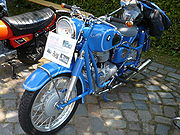
R27
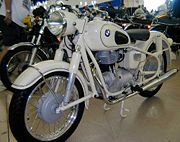
Overhead valve
An overhead valve engine, also informally called pushrod engine or I-head engine, is a type of piston engine that places the camshaft within the cylinder block , and uses pushrods or rods to actuate rocker arms above the cylinder...
vertical single was the only rubber-mounted thumper engine BMW ever produced, and was their last shaft drive single-cylinder motorcycle. The engine pumped out 18 hp, the highest ever for a shaft-drive BMW single. BMW manufactured 15,364 R27 models (engine numbers 372 001 – 387 566 ) over the production years of 1960 to 1966. Some of the 1966 R27 models were sold as 1967 models because dealers in those years often would assign dates to BMW motorcycles when they sold them, and not necessarily when they were manufactured.
BMW did things differently from other manufacturers. This is evident in the R27. Its enclosed shaft final drive is rare for a single cylinder motorcycle. But it also had a triangulated Earles front fork
Motorcycle fork
A motorcycle fork connects a motorcycle's front wheel and axle to its frame, typically via a pair of triple clamps. It typically incorporates the front suspension and front brake, and allows the bike to be steered via handlebars attached to the top clamp....
(named after English designer Ernest Earles); so the motorcycle had a front swingarm as well as a rear swingarm. When you squeezed the front brake lever hard not only did the front end not dive, it actually rose slightly. Thus, braking was a very steady activity, though the brakes were weak by today's standards. The engines crankshaft was laid out fore-to-aft, not side- to-side; also a rare feature. This way, the crank
Crankshaft
The crankshaft, sometimes casually abbreviated to crank, is the part of an engine which translates reciprocating linear piston motion into rotation...
and the final shaft were in line, and drive forces did not have to be run through a set of 90-degree gears. Also, the kick start
Kick start
Kick start refers to a method of starting an internal combustion engine by pushing a ratcheting lever with one's foot. Kick start mechanisms were almost universally a part of motorcycle engines before the mid-1970s, and were phased out of production over the next twenty years or so as electric...
er swung out sideways instead of parallel to the frame.
Technical data
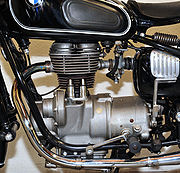
| R27 | |
|---|---|
| Engine Numbers | 372 001 – 387 566 |
| Design | Single cylinder with driveshaft |
| Engine | 4-stroke, 2 OHV Overhead valve An overhead valve engine, also informally called pushrod engine or I-head engine, is a type of piston engine that places the camshaft within the cylinder block , and uses pushrods or rods to actuate rocker arms above the cylinder... |
| Transmission Transmission (mechanics) A machine consists of a power source and a power transmission system, which provides controlled application of the power. Merriam-Webster defines transmission as: an assembly of parts including the speed-changing gears and the propeller shaft by which the power is transmitted from an engine to a... |
Four-speed, left foot |
| Model years | 1960–1966 |
| Number manufactured | 15,364 |
| Bore | colspan= " 1 " align= " center " | 68 millimetres (2.7 in) |
| Stroke | colspan= " 1 " align= " center " | 68 millimetres (2.7 in) |
| Capacity | 247 cc |
| Power | 18 hp @ 7400 rpm |
| Compression ratio | 8.2:1 |
| Fuel efficiency | 60.3 mpgus DIN 70030 |
| Maximum speed | 81 mph (130 km/h) / with side car 56 mph (90 km/h) |
| Wheelbase | 54.3 in (1,379 mm) |
| Curb weight Curb weight Curb weight or kerb weight is the total weight of a vehicle with standard equipment, all necessary operating consumables , a full tank of fuel, while not loaded with either passengers or cargo.This definition may differ from definitions used by governmental regulatory agencies or other... |
colspan= " 1 " align= " center " | 357 pounds (161.9 kg) |
| GVWR Gross vehicle weight rating A gross vehicle weight rating is the maximum allowable total weight of a road vehicle or trailer when loaded - i.e., including the weight of the vehicle itself plus passengers, and cargo.... |
colspan= " 1 " align= " center " | 716 pounds (324.8 kg) / with side car 1058 pounds (479.9 kg) |
| Tires front & rear | 3.25 x 18 |
| Battery | 6 volt, 9 Ah. |
| Tank capacity | 3.96 US gallon (15 liter) |
| Engine oil capacity | 2.6 US pint (1.2 liter) |
| Transmission capacity | 650 cc |
| Rear drive capacity | 125 cc |

